TMF Reference Model - The Case for Standards
The research and development process continues to be long, complex and costly. Sponsors are challenged with filling pipelines, conducting complex global clinical trials and complying with requirements for additional safety and efficacy data.
Background
The research and development process continues to be long, complex and costly. Sponsors are challenged with filling pipelines, conducting complex global clinical trials and complying with requirements for additional safety and efficacy data. Because of these challenges, clinical development has been targeted as a key area in need of greater efficiency. While costs associated with drug development are increasing at an annual rate of 11.8%, sales are growing at a much slower pace, in the range of 4.5% to 5.5% globally and 2% to 5% in the United States.1
According to the PhRMA 2012 profile2 the time to develop a drug is 10 to 15 years, and the average cost to develop a compound (including the cost of failures) is as follows:
1970s = $140 million*
Mid-1980s = $320 million*
Late 1990s = $800 million*
Early 2000s = $1.2 billion
As a result of these increased costs and the high rate of failure in clinical development, only two of ten marketed drugs return revenues that match or exceed R&D costs.
One of the many activities across the clinical development cycle that is non-negotiable is the creation, collection, management and storage of the documents that are contained in the Trial Master File (TMF). The TMF contains those essential documents that individually and collectively permit the evaluation of the conduct of a trial and the quality of the data produced. These documents serve to demonstrate the compliance of the investigator, sponsor, and monitor with the standards of good clinical practice (GCP) and with all applicable regulatory requirements.3
All sponsors - whether an individual, company, institution or organization - and investigators conducting clinical trials in life sciences (i.e. pharmaceutical, biotechnology, or device trials) are required to maintain documentation for each clinical trial. Regulatory guidance, such as ICH E6 section 8, addresses only a minimum sub-set of documents that are commonly retained; there are significantly more documents in a TMF as shown in Figure 1.
Figure 1 – Definition of a Trial Master File4
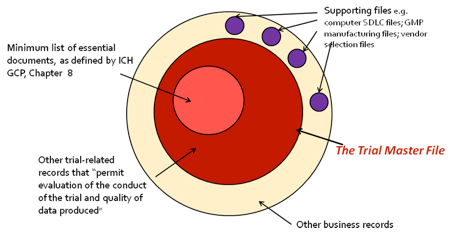
Historically, there has been no comprehensive, common industry model for a TMF and therefore each trial sponsor has its own unique TMF structure as defined by its Standard Operating procedures (SOPs). This is a highly inefficient way for our industry to work for many reasons:
- Sponsors and contract research organizations (CROs) expend considerable resources defining and redefining TMF content for each clinical trial. These are valueless activities for highly educated trial team members whose efforts are better directed to ensuring subject safety, protocol adherence and data quality.
- The burden is very high on smaller sponsors that may have limited financial resources and document management expertise.
- Records and information exchange between partners, in acquisitions and in outsourced trials is extremely cumbersome. Information searches are laborious, files are frequently restructured and productive knowledge sharing is significantly hampered -- major inhibiting factors for successful collaboration. Regulators consistently find different terminology and file structure, sponsor to sponsor – creating inefficiency and a higher degree of variability during inspection.
Rationale for a TMF Reference Model
To address the gap in TMF standards, in 2009 the TMF Reference Model team was initially created within the Document and Records Management Community of the Drug Information Association to develop a standardized taxonomy that outlines the clear definition and organization of TMF content using standard nomenclature. As of early 2013, the TMF Reference Model team is composed of over 330 representatives from more than 180 life science companies, contract research organizations, consultancies, technical vendors, industry groups, healthcare, academia, not-for-profit / NGO and regulatory agencies spread globally from the USA to Australia. The Asia-Pacific subgroup was an exciting addition in 2012, and to date there are already 25 members in the group.
The Model details the generic content that individually and/or collectively permit the evaluation of the conduct of a clinical trial and the quality of the data produced, in accordance with industry opinion and best practices. Company specific documents, dictated by SOPs, can be added. The Model is a reference for the industry and is not considered mandatory, but rather an opportunity for standardization across the industry. The Model can be adapted to an electronic or paper TMF. It does not endorse, nor require, any specific technology for application. The Model can be downloaded free from the DIA website at: http://www.diahome.org/en/News-and-Publications/Publications-and-Research/EDM-Corner.aspx.
Version 1.0 of the Model, first released in June of 2010, was updated in February of 2011 (V1.1) and again in December of 2011 (V1.2), based on broad feedback provided from end users and reviewers, including the UK and US regulatory agencies MHRA and FDA. Version 2.0 of the Model, released in June 2012, included numerous new aspects:
- The Investigator Site File is the part of the TMF found at the investigator site. The Model provides clarity on which content is common to every trial site (e.g. protocol), which is site specific (e.g. 1572), and details a few which are only included in the Investigator Site Files in a small number of countries.
- Device trial content is now also included in the Model, with reference back to ISO14155, both at the Sponsor and Investigator Site.
- Investigator Initiated Studies (IIS) are trials where an investigator also takes on the role and responsibilities of a trial Sponsor. The set of documents is as lean as possible while meeting ICH Guidelines and targeted regulatory requirements. The challenge is the variation of IIS trials and the acceptance and use of the Model by Investigator-Sponsors.
- Process related details for all content in the TMF are now included and provide an alternate perspective on the organization of the content.
Industry Surveys
A subgroup of the TMF RM Team developed the first industry benchmark TMF surveys. The intent was to gather data on the industry’s current TMF processes and to develop benchmarks for quality and effectiveness improvements, both in paper and electronic TMFs. The first survey was completed in 3Q2010, and the second survey followed in 1Q2012. The 2012 survey provides valuable data from 168 respondents (57% of which were sponsors) on current TMF practices. A 2013 survey is currently in progress.
Electronic Trial Master Files
The 2012 data indicates a significant growth in the number of organizations transitioning to eTMF. For inspection, 32% of survey respondents maintain paper TMFs, down from 50% in the corresponding 2010 survey. While there is only a modest increase in the number of respondents using eTMFs (8%) for inspection, the increase in the number of respondents maintaining a combination of paper and electronic TMFs was significant – 48% in 2012, compared to just 27% in 2010.
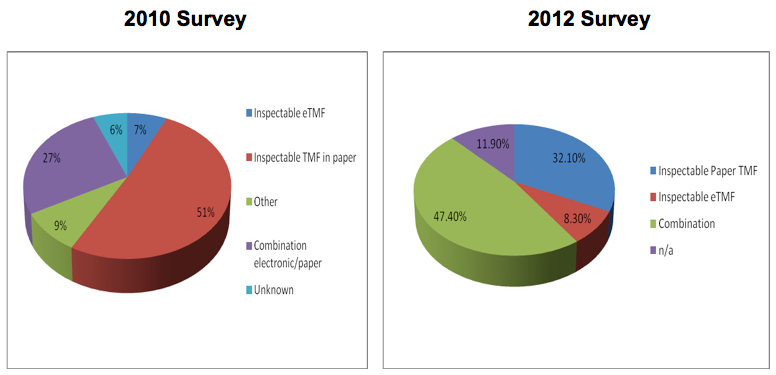
The 2012 data also shows an overall trend to implementing eTMFs. The 2012 survey reveals that 28% of the respondents are currently using an eTMF, and 57% are in the process of planning, building or evaluating eTMF. In the 2010 data, only 45% of respondents were actively building or evaluating eTMF. In the 2012 survey, only 3% of respondents replied that they are not considering eTMF.
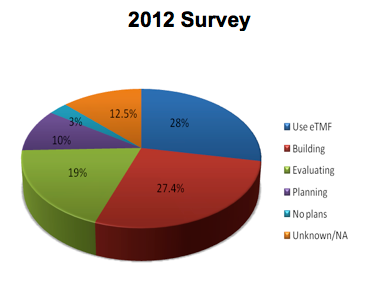
Process Efficiency
The 2012 survey results comparing process efficiency when using paper TMF vs. electronic TMF provide a compelling case for transition to an electronic Trial Master File.
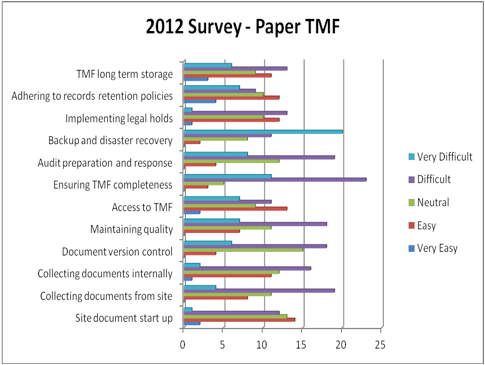
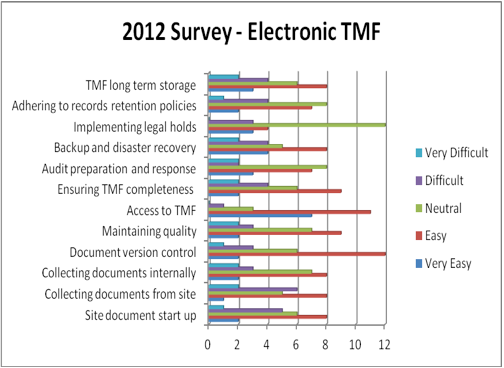
The 2012 data indicates further efficiencies can be realized when the Model is applied in an eTMF...


Case Studies
Below are case studies of efforts which provide insight and examples of how the Model has been implemented.
Case Study #1: Jamie Toth, Director, e-TMF Business Lead, Covance
Problem statement:
The clinical trial industry has extensive experience in managing paper-based Trial Master Files. The interpretation of what defines an essential document has been the scrutiny of many using the ICH GCP E8 Guidelines as a reference point. For CRO’s, such as Covance, this meant considering different interpretations of the reference plus ensuring the flexibility to include anything considered part of a Sponsor’s interpretation of the reference. The TMF Index became lengthy, standards across studies were lost, and developing a TMF Index for a new study would be similar to starting from scratch each time. This loss of efficiency at study start was critical.
Solution:
In 2011, there was a shift in how the industry was looking at eTMFs. Covance was ready to build a new TMF to support their needs and ensure it was broad and adaptive for their Sponsors. We investigated required changes, and updated our internal filing processes. The new TMF Reference Model from the Drug Information Association (DIA) Working Group was released in June 2010 and our internal project started the following January.
Consistency with data governance and regulatory standards, controlling costs, and satisfying our Sponsors’ needs, required a standard and efficient way of filing essential documents while ensuring the TMF was audit-ready. We aligned leaders to each of the 11 TMF Reference Model zones. The Zone Leaders systematically conducted an analysis of how they were historically filing within the zone, comparing it to the TMF Reference Model, and considered how they wanted to file in the future. This effort was not trivial, nor should be under-estimated.
In early 2011, approximately 65+ employees globally, representing all disciplines of clinical development operations, worked together to map the historical TMF Index to the TMF Reference Model, categorizing each artifact (value-added or wet-ink) and ultimately developed the future state TMF Index. Looking across the operations, Phase I – Phase IV, each Zone obtained agreement from key stakeholders. Critically important to the effort was ensuring buy-in from the various parties responsible for translating these processes to our Sponsors.
Result:
While the work may not have been trivial (~12 months and ~65 people), it was an important milestone in building the TMF structure that would eventually become our new eTMF system. The new TMF Index is being used with all in-flight paper studies and within the eTMF system launched in September 2012. Through the work of this team, we removed ~72 business file documents, resulting in a significant reduction of filing work effort. We continue to evaluate the TMF Reference Model updates as they are released. Our process evaluates the updates and determines whether to incorporate the updates into our TMF Index via a Change Control Review Board, which implements changes for the TMF Index and SOPs, in addition to the eTMF system configuration.
Case Study #2: Martin Thorley, TMF Content Integration Lead, Pfizer
Pfizer is currently implementing a new eTMF process and software solution where the focus has been very much on quality and standards. At any point in time Pfizer has hundreds and hundreds of clinical trials ongoing in every size, shape and form. Therefore, having consistency of quality and standards is crucial to the success of managing and demonstrating control of a Study TMF.
Implementing a single eTMF repository has beneficial outcomes to multiple aspects of clinical trial management.
Among the many benefits to using a central single eTMF repository are the ability to present a cohesive and centrally accessible TMF to study teams, auditors and inspectors in any geographical location as well as interoperability with other systems and supporting downstream activities. This eliminates the need for:
- Extraction of or providing access to content stored in more than one repository
- Transportation and subsequent storage of paper.
Because getting content out is equally as important as getting content in, utilizing standards in the form of metadata not only ensures consistency in what is put into the eTMF but makes the possibility of retrieving the content more robust. Additionally, interoperability of a single eTMF with other systems, i.e. CTMS, brings huge benefits in the reusability of data and elimination of transcriptional errors as well as the need for extensive, expensive and duplicative QC processes.
When managing several hundred studies and working with many external collaborators, the TMF standards facilitate consistency and transparency in control and management of a clinical trial. In the construction of the Pfizer TMF Document List, we utilized and mapped to the TMF Reference Model which enables alignment with the industry wide reference model and consistent use of metadata.
Benefits/Opportunities
Who Benefits from a TMF Reference Model?
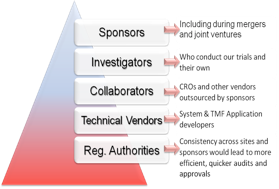
- Life science companies of any size, both commercial and institutional, involved in clinical trials.
- Clinical trial team members, including trial and data management, clinical supplies, biostatistics, etc.
- Contract Research Organizations and vendors supporting TMFs
- Site staff, including investigators and coordinators.
- Regulators challenged with varying TMF terminology and file structures, which create inefficiency and a higher degree of variability during sponsor inspections
Improved Process Efficiency
How does the TMF RM facilitate process efficiency?
- Sponsors and CROs expend considerable resources defining the content of the trial master file for each clinical trial and often have different naming conventions for artifacts. Consequently, contributors and regulators have the challenge of adapting to different formats and TMF structures with each clinical trial. The burden of structuring a TMF can also be very high for smaller companies that usually have limited document management bandwidth and limited financial resources.
- Successful completion of a clinical trial requires collaboration among geographically distributed project team members – presenting unique challenges that often require manual intervention. TMF content collection frequently drives trial processes, and having timely access to this content is imperative.
- Content interchange is also an area which presents significant challenges. In many cases, management of the TMF is outsourced to multiple CROs for different studies and programs. Each CRO typically has their own internal TMF conventions which are aligned to their internal procedures. Once the TMF is transferred back to the sponsor, it is frequently adapted to their structure and standards in order to manage the records. This can be even more complex if the sponsor uses an electronic records management system. When it comes to partnering or transferring records, information exchange between companies can be extremely cumbersome, and impedes successful collaboration.
- Regulators and auditors are challenged with varying conventions, terminology and file structures, creating inefficiency and a higher degree of variability during quality audits and regulatory inspections.
The Case for the TMF Reference Model becoming a Standard?
Taking all of the facts into account, should the TMF Reference Model become in Industry Standard? A Standard can be defined as “something considered by an authority or by general consent as a basis of comparison; an approved model”.
An effective standard includes the following key features:
- Flexible (a rigid standard won’t get adopted)
- Simple to understand
- Sufficient granularity
- Value adding
- Free
- Unique
- Globally applicable
- Appropriate to other standards
- Include implementation guide
- Defined scope
- Champion for adoption of the standard
- Owner - how will the standard be maintained
Many standards fail due to lack of compliance, communication to the relevant community, lack of compatibility with reality and an inability to map to the current common situation. If the Model is to become a Standard, then these pitfalls need to be avoided.
Conclusion
The case studies and our 2010 and 2012 surveys provide compelling data and a clear case for establishing a common model for the organization and management of the Trial Master File. Standards promote interoperability, increase quality and reduce effort for all clinical trials and are foundational for transition to an electronic Trial Master File, which provides significant process efficiencies in the conduct of clinical trials.
As the Model continues to evolve through implementation and improvement, there is an opportunity to offset some of the challenges that industry is currently facing. Establishing consensus and working as a group rather than individually will ensure that the Model is an enduring standard which continues to provide significant value to all participants in the R&D process.
It ain’t easy, but it’s worth it.
You are invited to follow TMF RM activities on LinkedIn by joining the TMF Reference Model group
About the Authors
Maryanne Quinn, President, Integrated Submission Strategies (ISS), is Chair of the TMF RM Communication Team and has over 25 years of experience in the Life Sciences Industry and can be reached at ISS.Quinn@verizon.net
Karen Redding, Global Business Development Director of Phlexglobal, is the Co-Chair of the TMF Reference Model Group and can be reached at kredding@phlexglobal.com
Fran Ross, Principal Consultant, Clin/Reg Optimization | Paragon Solutions, is Chair of the TMF RM Survey Team and Lead for Asia Pacific SubTeam and can be reached at fross@consultparagon.com
Editor’s Note: A version of this article is currently in peer-review and is slated to appear in Applied Clinical Trials magazine in 2014.
References
1. Neuer, et al., “The Upfront Cost Hurdle of EDC”, Applied Clinical Trials Online, April 1, 2010
2. 2012 PhRMA 2012 Profile; www.pharma.org
3. ICH Guideline for Good Clinical Practice, E 6, Section 8
4. Rammell Consulting, Ltd.
Unifying Industry to Better Understand GCP Guidance
May 7th 2025In this episode of the Applied Clinical Trials Podcast, David Nickerson, head of clinical quality management at EMD Serono; and Arlene Lee, director of product management, data quality & risk management solutions at Medidata, discuss the newest ICH E6(R3) GCP guidelines as well as how TransCelerate and ACRO have partnered to help stakeholders better acclimate to these guidelines.
Effect of AI/ML, Real World Evidence and Master Protocols on Trial Success
July 7th 2025How the application of artificial intelligence, broader use of real-world evidence, decentralized clinical trials, master protocols, and risk-based quality monitoring, together with strong ethical oversight and increased collaboration, are contributing to better healthcare delivery and strengthening the role of clinical research in driving global health progress.
FDA Grants Priority Review to Merck’s sBLA for Winrevair After Early Success in ZENITH PAH Trial
July 2nd 2025Merck’s bid to update Winrevair’s label advances with FDA priority review, backed by Phase III ZENITH data showing a 76% reduction in major morbidity and mortality events in patients with pulmonary arterial hypertension.